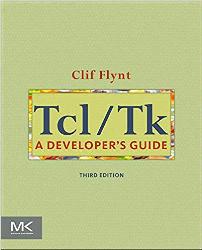
Noumena Corporation
Whitmore Lake
Michigan
For those who prefer to learn on their own, Noumena recommends TclTutor and Tcl/Tk: A Developer's Guide.

For those who prefer to learn on their own, Noumena recommends TclTutor and Tcl/Tk: A Developer's Guide.

Tcl is the Open Source movement's biggest hidden success story. It runs the telecom industry from the EDA tools used to design the chips to the test platforms that validate them up to the applications that run on Cisco Routers and AOL's web server.
The language supports modern constructs like catch/throw error handling, encapsulation, modularization and Object Oriented. It's fast and easy to learn, and powerful enough for the US DoD and NBC Broadcasting studios.
My book's goal is to bring a programmer up to speed on Tcl/Tk as quickly as possible. I describe the basics of the Tcl/Tk language, techniques for using it effectively, and tools for helping you develop applications better and faster.
A few Barnes & Noble's Bookstores keep
Tcl/Tk: A Developer's Guide in stock. If your local book dealer
doesn't stock it, feel free to tell them that they should stock my book. :-)
A quick overview of what Tcl/Tk offers the developer.
The low level functions of how to run the interpreter,
what the prompts are, etc.
Describes the Tcl syntax, substitutions, data types, a subset of
the core commands, and offers short examples of use.
Describes how to access the file system, perform I/O with
files, users, and client/server sockets.
How to find patterns and parse data in strings and lists.
Using regular expressions and modularizing with procedures.
How to use the Tcl Array, how to examine the state of the interpreter,
and an example of building complex data structures (a splay tree) in Tcl.
Using procedures to implement object oriented style programming in Tcl.
How the namespace command command works, and how to use it for
data and procedure encapsulation. How to use the package command
for modules.
The basics of TclOO. Creating classes, inheritance, mixins
More techniques for TclOO. Class methods, class variables and dynamic
classes.
The basic widgets, how to use the geometry managers.
Things you can do with the canvas including finding and modifying
displayed items, binding actions to displayed items and creating
new pure Tk widgets.
How to use the text widget, and the htmllib package.
You can build complex widgets out of the basic building blocks.
This chapter describes how to do it.
One of Tcl's strengths is how easy it is to add new functionality
to the interpreter. This chapter explains how to do it.
Using threads, the interp command and the event loop
Descriptions of several popular packages with enough information
to start using them. Discusses incr Tcl, Expect, TclX, SybTcl, OraTcl,
MySQLTcl, VSdb, BWidgets, BLT, and the img extension.
Descriptions of several application development tools, both freeware
and commercial. Includes code formatters, checkers, debuggers, GUI
generators, compilers wrappers extension generators and IDEs.
A collection of tips and tricks and a list of common mistakes
You can also order Tcl/Tk: A Developer's Guide from Amazon
Books, enjoy Amazon's low prices, and have the book shipped to your
door by clicking the Buy button to the left.
Return to Noumena Home Page